
|
|
The Maghas of Kausambi appear to be a dynasty which gained control of the area around Kausambi during the period when the Kushan empire was in its decline and the
Gupta empire had not yet emerged. They are called the Maghas because several of the kings have names ending in -magha, but we do not know what they called themselves.
The Puranas mention a dynasty called the Meghas and some have equated these with the Maghas, but others dispute this. Ashvini Agrawal has pointed out that the Puranas
definitively place the Meghas in Kosala, but no trace of the Maghas have been found there. Instead, inscriptions and coins of the Maghas have been found in an area from
Allahabad to Fatehpur, corresponding to the area of the ancient kingdom of Vatsa.
Excavations at Kausambi revealed a chronology that seemed to indicate that a king named Nava held sway there shortly after the Kushan king Vasudeva I, and he was
followed by the Magha kings. There are dated inscriptions of several of the Maghas, with dates ranging from 51 to 139 (the actual known dates are 51, 81, 83, 86, 87, 107,
130, and 139). Which era these dates belong to has been a matter
of considerable debate, but the most logical proposal is that of Pieper, who suggests that they must belong to the Kushan or Kanishka era. Since the Kushans were the
pre-eminent power in the region just prior to this time, it makes sense that their minor successors would continue to use their dating system. Leaving aside the 51 date for the
moment, the dates of 81-139 of the Kanishka era would correspond to CE years 208-266, which fits beautifully within the post-Vasudeva (reign ended c. 198 CE) pre-Gupta
(c. 320) period.
The year 51, however, which comes from an inscription of Bhimasena, is problematic. If dated in the Kanishka era, this would be 178 CE, at which time Huvishka would
still have been in power. Given this, as Pieper points out, "it is improbable that Bhimasena was an independent king of Kausambi at the time." The solution to this problem
is that Bhimasena may have been ruling not in Kausambi, but in Bandhogarh, where his inscription was found. Bandhogarh is in modern Madhya Pradesh, some 300 km south of
Kausambi. Agrawal has argued that he may well have "succeeded in carving out a small principality for himself in the hill tracts of Baghelkhand beyond the easy reach of the
Kushans." Agrawal then goes on to resolve the seeming conflict between the dates of Bhadramagha and Praushthasri ... the latter must have continued to rule in the
Bandhogarh area, where his inscriptions are found, while Bhadramagha gained power in Kausambi as the Kushan power waned. At least by the time of Vaisravana, these two
areas seem to have come under one rule, as his inscriptions have been found in both Bandhogarh and Kausambi.
If this view is accepted, a possible dynastic list, with the known dates, would be:
Bhimasena (51 = 178 CE)
(Maharaja) Magha
Bhadramagha (81-87 = 208-214 CE)
Praushthasri (86-87 = 213-214 CE)
Bhattadeva (90 = 217 CE)
Sivamagha I (Kautsiputra)
Vaisravana (107 = 234 CE)
Sivamagha II (Gautamiputra)
Bhimavarman (130-139 = 257-266 CE)
Vijayamagha
Several other rulers are known, including Jayamagha, Rudramagha, Satamagha, and others.
|
 |
Maghas |
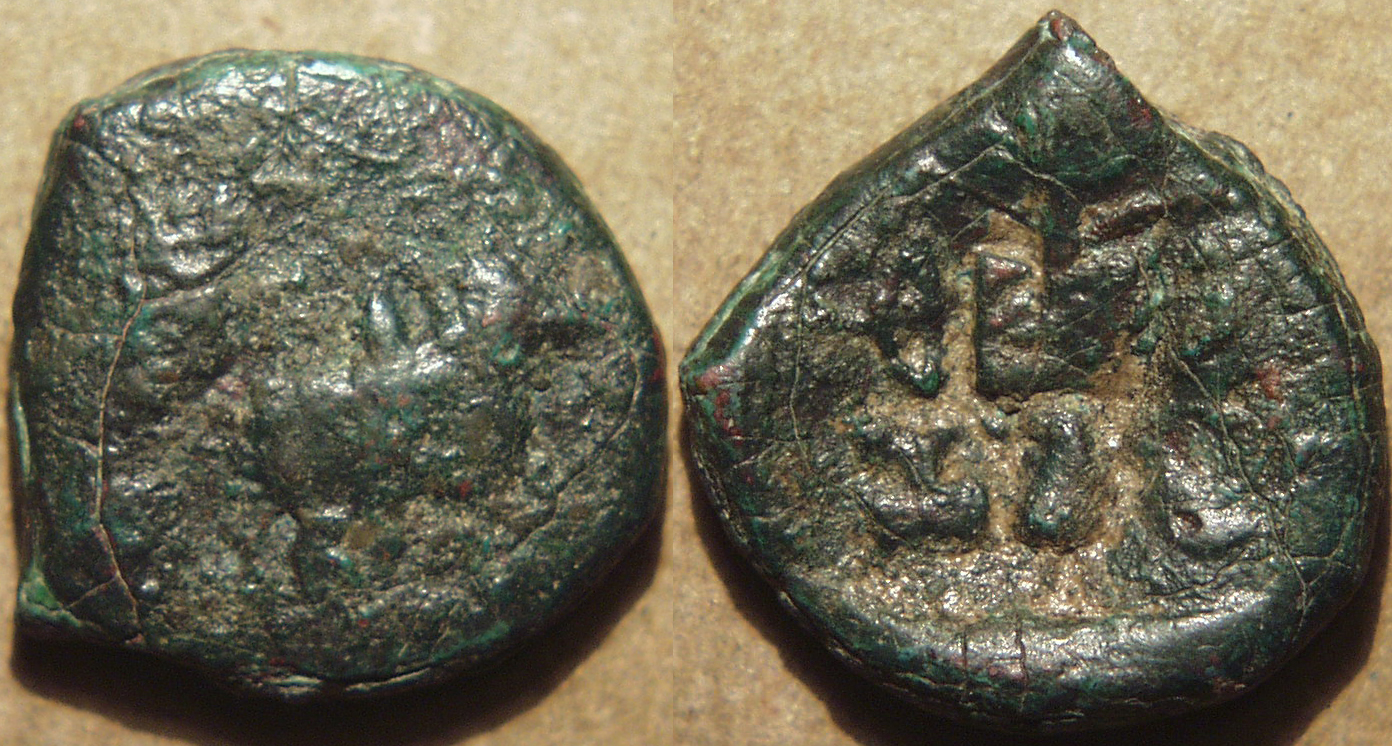
|
Nava, AE unit, c. 200 CE
Weight: 3.04 gm., Diam: 17 mm.
Obverse: Humped bull right /
Reverse: Bow and arrow, railed tree and indistinct symbol,
Brahmi legend below: navasa
Ref: Pieper 999
|
 |
Nava may not have been a Magha king, but a post-Kushan ruler in Kausambi. |

|
Nava, AE unit, c. 200 CE
Weight: 2.43 gm., Diam: 14 mm.
Obverse: Humped bull right /
Reverse: Bow and arrow, railed tree and indistinct symbol,
Brahmi legend below: navasa
Ref: Pieper 999
|

|
Nava, AE unit, c. 200 CE
Weight: 4.48 gm., Diam: 17 mm.
Obverse: Humped bull right, trident above /
Reverse: Spear or trident with axe on shaft at left, Railed tree and indistinct symbol,
Brahmi legend below: navasa, ladder symbol below that
Ref: Pieper 1000 (plate coin, photo, courtesy Wilfried Pieper)
|
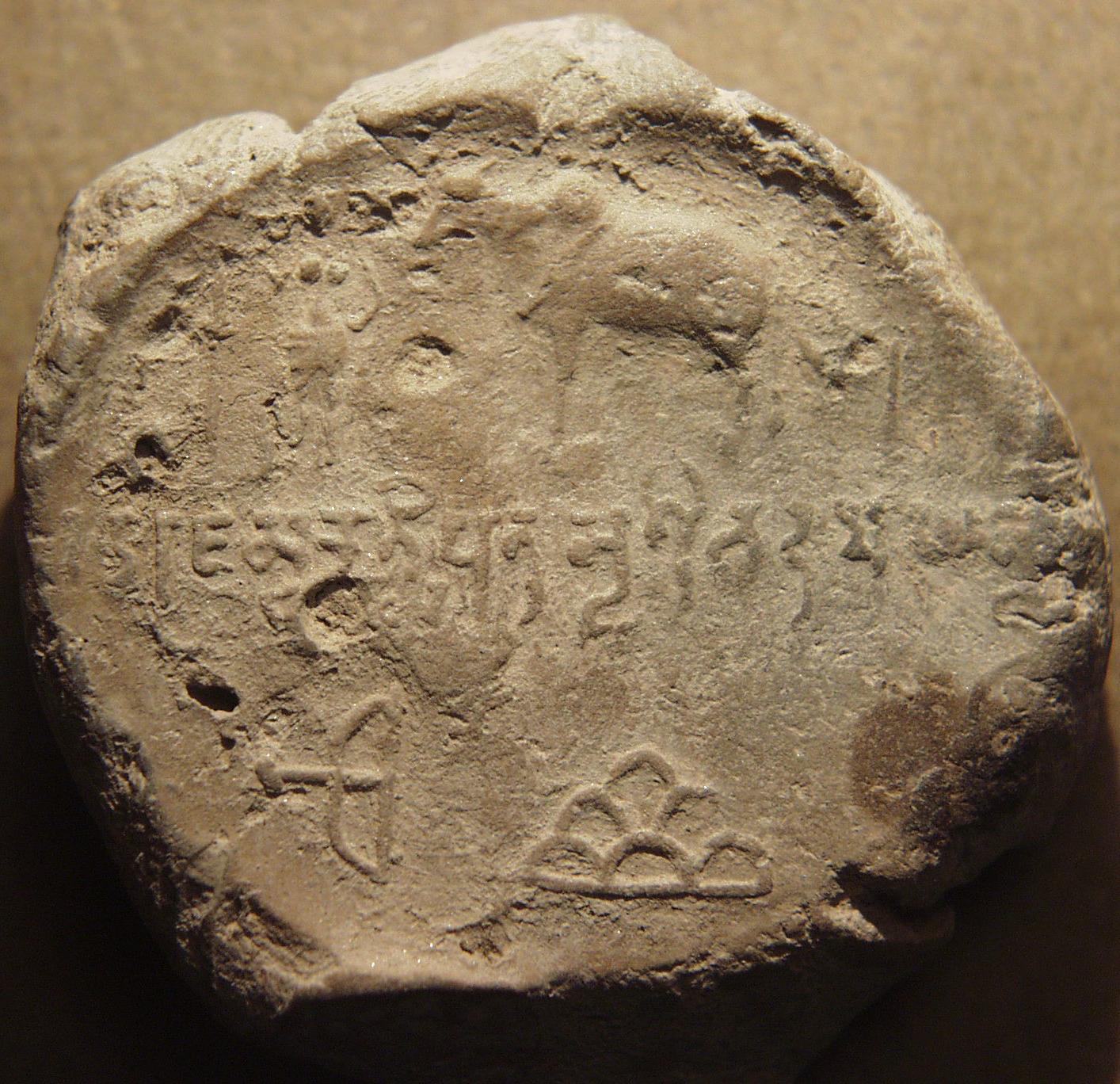
|
Bhadramagha, clay sealing, c. 208-214 CE
Weight: 15.78 gm., Diam: 38 mm.
Brahmi legend: maharajasya kotsiputrasya sri bhadramaghasya
Above: Bull left, with goddess standing at left and indistinct symbol at right,
Below: Bow and arrow and six-arched hill or chaitya
Ref: Unpublished
|
 |
The coins of Bhadramagha are quite rare, and they are crude like other Magha coins. The fine
carving on this seal shows that the Magha die cutters were capable of high quality work. |
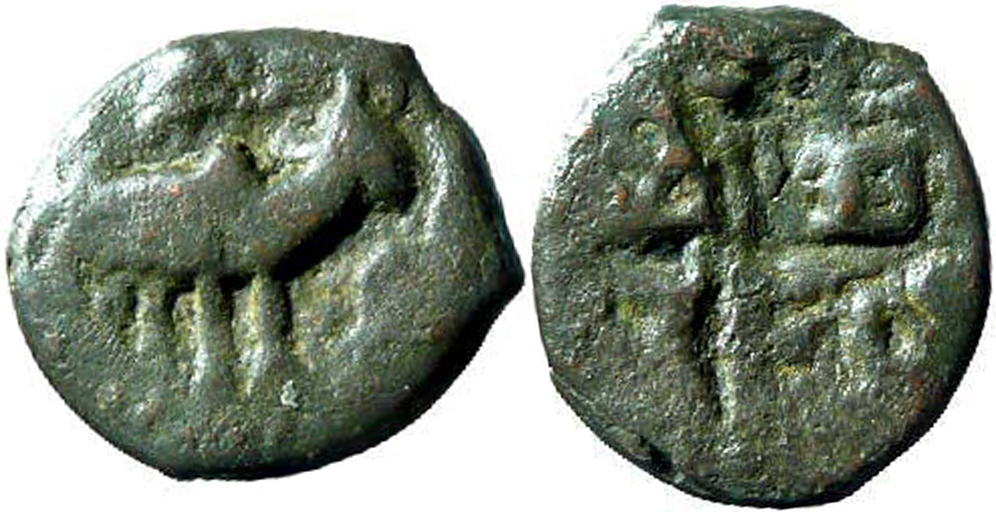
|
Vijayamagha, AE unit, c. 215-220 CE ?
Weight: 2.60 gm., Diam: 16 mm.
Obverse: Humped bull right /
Reverse: Railed tree and three-arched hill, Brahmi legend below: vija(yamagha)
Ref: Pieper 1004 (plate coin, photo, courtesy Wilfried Pieper)
|
 |
We do not have a date or other clue to the chronology for Vjayamagha. However, his coin
appears to be similar in style to the coins of Nava or Sivamagha I; thus this seems like a logical chronological point to place him. As a piece of
additional evidence, we have a published clay sealing of Vijayamagha which is very similar to the Bhadramagha sealing above; thus these two
rulers were quite likely close to one another in time. |
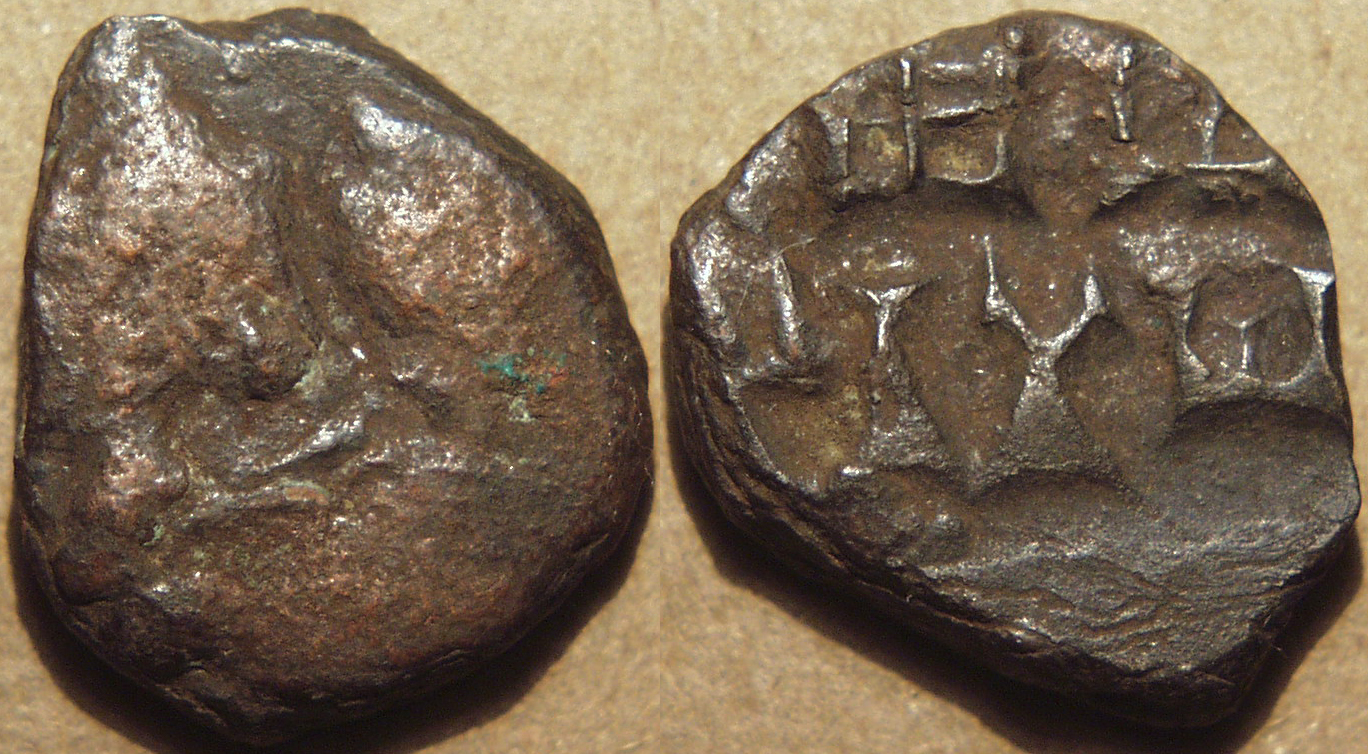
|
Sivamagha I, AE unit, c. 220-225 CE
Weight: 3.43 gm., Diam: 16 mm.
Obverse: Humped bull right /
Reverse: Railed tree and three-arched hill, Brahmi legend below: (s)ivamagha
Ref: Pieper 1001
|
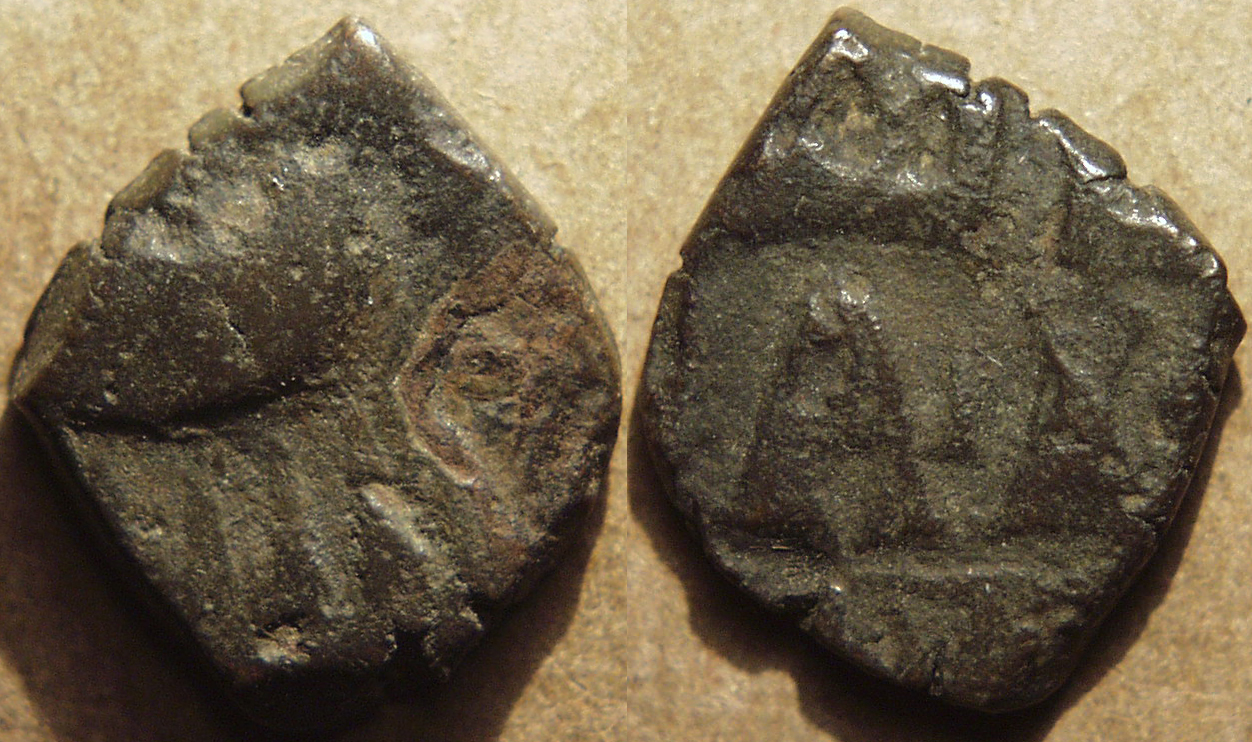
|
Sivamagha I, AE unit, c. 220-225 CE
Weight: 3.05 gm., Diam: 15 mm.
Obverse: Humped bull right /
Reverse: Railed tree and three-arched hill, Brahmi legend below: siva(magha),
ladder-like symbol below that
Ref: Pieper 1001
|

|
Sivamagha I, AE unit, c. 220-225 CE
Weight: 3.16 gm., Diam: 15 mm.
Obverse: Humped bull right /
Reverse: Railed tree and three-arched hill, Brahmi legend below: (si)vamagha,
ladder-like symbol below that
Ref: Pieper 1001 (plate coin, photo, courtesy Wilfried Pieper)
|

|
Vaisravana, AE unit, c. 230-235 CE
Weight: 3.03 gm., Diam: 15 mm.
Obverse: Indistinct /
Reverse: Railed tree and three-arched hill, Brahmi legend below: (vaii)srava(na)
Ref: Pieper 1002-1003
|

|
Vaisravana, AE unit, c. 230-235 CE
Weight: 2.49 gm., Diam: 16 mm.
Obverse: Indistinct /
Reverse: Railed tree and three-arched hill, Brahmi legend below: vaiisrava(na),
ladder-like symbol below that
Ref: Pieper 1002-1003
|
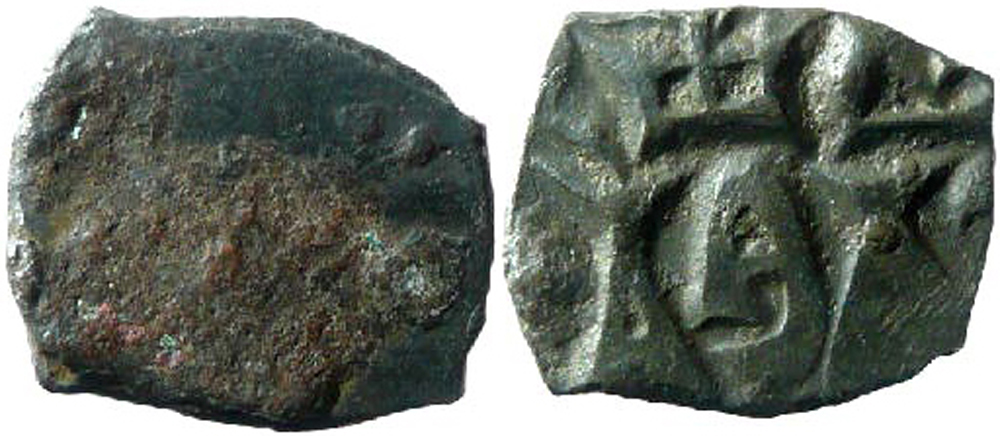
|
Vaisravana, AE unit, c. 230-235 CE
Weight: 2.28 gm., Diam: 16-13 mm.
Obverse: Indistinct /
Reverse: Railed tree and three-arched hill, Brahmi legend below: vaiisrava(na)
Ref: Pieper 1002 (plate coin, photo, courtesy Wilfried Pieper)
|
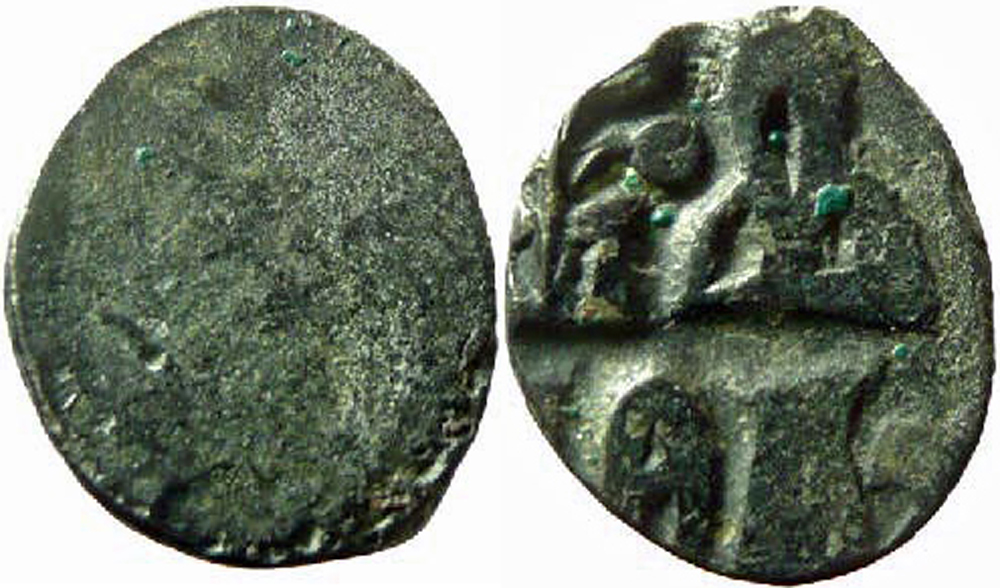
|
Vaisravana, AE unit, c. 230-235 CE
Weight: 2.14 gm., Diam: 15 mm.
Obverse: Indistinct /
Reverse: Railed tree and three-arched hill, Brahmi legend below: (vaii)srava(na)
Ref: Pieper 1003 (plate coin, photo, courtesy Wilfried Pieper)
|

|
Bhimavarman, AE unit, c. 257-265 CE
Weight: 2.20 gm., Diam: 13 mm.
Obverse: Indistinct or blank/
Reverse: Three-arched hill and railed tree, Brahmi legend below: (bhi)mavama
Ref: Pieper ---
|
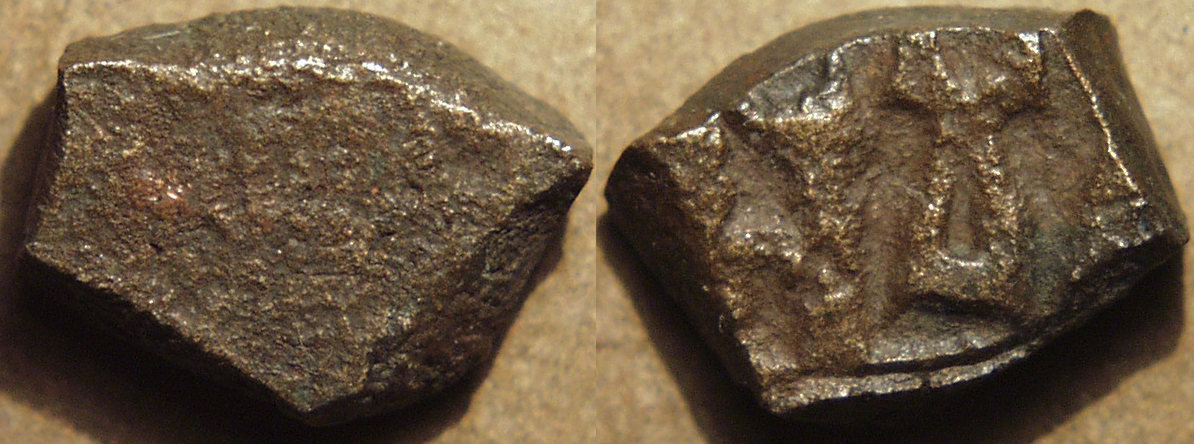
|
Bhimavarman, AE unit, c. 257-265 CE
Weight: 2.51 gm., Diam: 13-10 mm.
Obverse: Indistinct or blank/
Reverse: Brahmi legend: bhima(vama)
Ref: Pieper ---
|

|
Bhimavarman, AE unit, c. 257-265 CE
Weight: n.a., Diam: n.a.
Obverse: Bull left, indistinct symbol above /
Reverse: Symbols (railed tree, hill ?), Brahmi legend below: bhimavama
ladder-like symbol below that
Ref: Pieper ---
Photo courtesy Shailen Bhandare
|
|
|